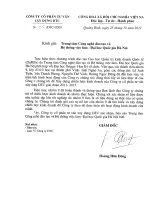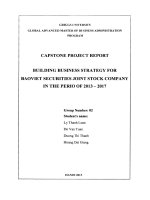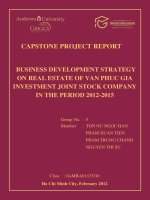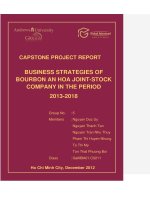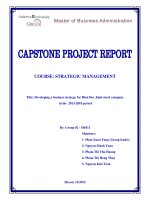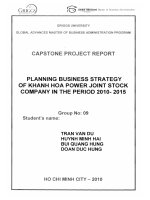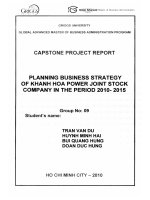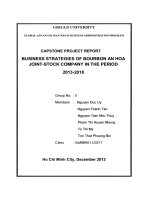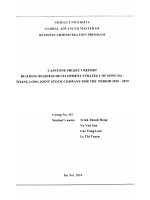Business development strategy on real estate of Van Phuc Gia investment joint stock company in the perrion 2012-2015
Bạn đang xem bản rút gọn của tài liệu. Xem và tải ngay bản đầy đủ của tài liệu tại đây (2.32 MB, 86 trang )
CAPSTONE PROJECT REPORT
Group No. : 5
Member : TON NU NGOC HAN
PHAM XUAN TIEN
PHAM TRUNG CHANH
NGUYEN THI SU
Class : GaMBA01.C0310
Ho Chi Minh City, February 2012
BUSINESS DEVELOPMENT STRATEGY
ON REAL ESTATE OF VAN PHUC GIA
INVESTMENT JOINT STOCK COMPANY
IN THE PERIOD 2012-2015
GLOBAL ADVANCED MASTER OF BUSINESS
ADMINISTRATION PROGRAM
CAPSTONE PROJECT REPORT
BUSINESS DEVELOPMENT STRATEGY
ON REAL ESTATE OF VAN PHUC GIA
INVESTMENT JOINT STOCK COMPANY
IN THE PERIOD 2012-2015
GROUP 5
TON NU NGOC HAN
PHAM XUANTIEN
PHAM TRUNG CHANH
NGUYEN THI SU
HO CHI MINH City - 2012
Strategic Management – Group 5 C0310
i
COMMITMENT
The Group 5, which comprises following members: Ton Nu Ngoc Han,
Pham Xuan Tien, Pham Trung Chanh and Nguyen Thi Su, would like to show
its guarantee in its truthfulness that the final exercise named “Business
development strategy on real estate of Vanphucgia Investment Joint Stock
Company for the period 2012 – 2015” is the joint-implementation research
work of Group 5 itself.
The citation of used data in this exercise is cleary shown in the list of
reference. In addition, this research result has not been published in any
research work up to now.
Ho Chi Minh City, 15
th
Mar., 2012.
Implementing group
Group 5 – Class of GaMBA01.C0310
Strategic Management – Group 5 C0310
ii
ACKNOWLEDGEMENT
The accomplishment of the final exercise, a hard and difficult mission to
overcome, is a result of our nearly 2-year strenuous and difficult study, as a
preliminarily obtained certain achievement from our careers of study and research.
In addition to our own efforts, this result is also contributed by enthusiastic
interests, guidance and helps from people around us. We would like to show our
warmest thanks to the Center for Educational Technology and Career Development
of the Vietnam National University, Hanoi for their facilitation throughout the
MBA training program of the Griggs University - America.
We also would like to express our deep gratitude to our lecturers for their
enthusiasms and whole-hearted conveyance and transfer of precious knowledge that
are really useful for our career development.
Our sincere thanks are expressed to the guiding Council, especially the lecturer
and Dr. Le Van Bay for his whole-hearted instructions and helps regarding the
completion of this final exercise.
Furthermore, we would like to send our gratitude and thanks to the
management Board of the Vanphucgia Investment Joint Stock Company due to
their facilitation, contribution of ideas and provision of valuable data and
information for our group’s research.
Our thanks are directed to our classmates who are always willing to help us
acquiring practical and useful lessons by their own practical experience and
knowledge.
Finally, we would like to send our most sincere and grateful thanks to our
families due to their constant encouragements and facilitations for the participation
and the completion of our training courses.
Our most sincere and deepest gratitude are expressed for everybody!
Group 5 – Class of GaMBA01.C0310
Strategic Management – Group 5 C0310
iii
TABLE OF CONTENTS
PREFACE 1
1. Background 1
2. Research objectives 2
3. Research scope 3
4. Research methodology 3
5. Topic structure: 3
CHAPTER 1 4
THE PRINCIPLE OF BUSINESS STRATEGY 4
AND REAL ESTATE TRADING 4
1.1 The principle of strategic management 4
1.1.1 Definition of strategic management 4
1.1.2 Classification of strategic management 5
1.1.2.1. Different levels of strategy 5
1.1.2.2. Types of Strategy 5
1.1.3 Process of strategic management 7
1.1.3.1. Strategy formulation 8
1.1.3.2. Strategy implementation 19
1.1.3.3. Strategy evaluation 19
1.2 Current status of real estate market in Ho Chi Minh City 19
1.3 The necessity of real estate business trategy planning of VPG. 21
CHAPTER 2 22
ANALYSIS OF BUSINESS AND MANUFACTURING STATUS AND THE REAL-
ESTATE BUSINESS OF VPG 22
2.1. The establishment and development of VPG: 22
2.1.1. Company introduciton: 22
2.1.2 Business sectors of the Company: 23
2.1.3. Legal capital increase: 23
2.2. Organization structure – roles and duties of divisions: 24
2.2.1. Organizational structure: 24
2.2.2. Roles and duties of divisions: 25
2.3. Evaluation of business performance of VPG in the period 2009-2011: 29
2.3.1. Real-estate business and investment 29
2.3.2 The consultancy of design, investment project proposal and construction works. 32
2.3.3 Real-estate broking service and office for lease 33
Strategic Management – Group 5 C0310
iv
2.3.4. Business achievements of VPG in the period 2009-2011: 34
2.3.4.1. General business achievements, comments and evaluations: 34
2.3.4.2 Business achievement in real-estate investment: 40
2.3.4.3 Business achievement in construction: 41
2.3.2.4 Business achievement in consultancy and others: 42
2.4. Analysis and evaluation of the current business strategy of VPG 42
2.4.1. Advantages 42
2.4.2. Difficulties 44
2.4.3. Evaluation of achievements and existing limitations 45
CHAPTER 3 48
PLANNING STRATEGY AND SOLUTION TO DEVELOP VPG’S REAL ESTATE
BUSINESS - RECOMMENDATIONS 48
3.1. Mission, vision of the VPG 48
3.1.1.Mission of the company: 48
3.1.2 Vision: 48
3.2. Strategical objectives: 48
3.3. Planning strategy: 48
3.3.1. Analysis of business enviroment 48
3.3.1.1. Macroeconomic situation 48
3.3.1.2. Analysis of external environment 51
3.3.1.3. Internal factors analysis 56
3.3.1.4 SWOT Matrix of VPG 58
3.3.1.5 SPACE Matrix of VPG 62
3.3.1.6. Competitive picture matrix (CPM) 64
3.3.1.7. Quantitative strategy picture matrix (QSPM) 65
3.4. Solutions to implementing strategies 67
3.4.1. Capital solution 67
3.4.2. Product solutions 68
3.4.3. Solutions for human resources 68
3.4.4. Solutions for cost 69
3.4.5. Solutions for quality and progress management. 69
3.4.6. Solutions for Marketing and sales organization: 70
3.5 Proposed revenue and profit in 2012-2015 71
3.6 Recommendations: 72
CONCLUSION 73
REFERENCES 78
Strategic Management – Group 5 C0310
v
LIST OF TABLES
Table 1.1. External Factor Evaluation Matrix (EFE) 11
Table 1.2. Internal Factor Evaluation Matrix (IFE) 12
Table 1.3. CPM Matrix 15
Table 1.4. QSPM matrix 18
Table 2.1: Business achievements in the period 2009-2011 34
Table 2.2: Analysis of some basic financial indicators of VPG 39
Table 2.3: Revenue, real-estate business profit 40
Table 2.4: Revenue, construction business profit 41
Table 2.5: Revenue, consultancy profit and others 42
Table 3.1: External Factor Evaluation (EFE) Matrix of VPG 55
Table 3.2: Internal factors evaluation Matrix of VPG 58
Table 3.3: Factors plotted on the axises of SPACE Matrix 62
Table 3.4: Competitive picture matrix 64
Table 3.5: QSPM matrix 66
Table 3.6: Proposed revenue structure in 2012-2015 71
Table 3.7: Proposed profit structure 2012-2015 71
Table 3.8: Proposed business results in 2012-2015 72
Strategic Management – Group 5 C0310
vi
LIST OF FIGURES, GRAPHS
Figure 1.1. Comprehensive model of the strategic management process 8
Figure 1.2. A model of five competitive forces designed 9
Figure 1.3. SWOT matrix 13
Figure 1.4. SPACE matrix 13
Figure 1.5. Grand Strategy Matrix 16
Figure 2.1: Organizational structure of VPG 24
Figure 2.2: Perspective of corporative housing B1 Truong SA 29
Figure 2.3: Perspective of corporative housing project Truong Dinh Hoi 3 30
Figure 2.4: Perspective of housing project in Le Minh Xuan 31
Figure 2.5: Revenues of VPG in the period 2009-2011 35
Figure 2.6: VPG’s Profits in the period 2009 – 2011 35
Figure 2.7: Revenues, costs and profits 2009 - 2011 of VPG 36
Figure 2.8: Cash and inventory 2009 - 2011 of VPG 37
Figure 2.9: Assets Structure in period 2009 - 2011 of VPG 38
Figure 2.10: Capital Structure in period 2009 - 2011 of VPG 38
Figure 3.1: SWOT Matrix 61
Figure 3.2: Competitive strategy of SPACE Matrix 63
Strategic Management – Group 5 C0310
1
BUSINESS DEVELOPMENT STRATEGY ON REAL
ESTATE OF VAN PHUC GIA INVESTMENT JOINT STOCK
COMPANY FOR THE PERIOD 2012-2015
PREFACE
1. Background
Real estate is considered as one of the key business sectors in the national
economy, which has obtained a great deal of profits and socio beneficial values during
its prosperous period. Up to Apr. 2011, a sharpest increase was remarked to the real
estate value in every channel of investment. Taking the time of Dec. 2000 for
comparison, USD exchange rate increased 1,5 times, saving account service roughly
scored a 2.5-fold price increase , VN-Index took an approximation of 4,8-fold mark
increase, gold reached a 7.6-fold price increase, while real estate roughly owned an 8-
fold increase. The huge profit in real-estate sector attracted the participation of a great
deal of investors, facilitated the newly established real-estate companies in every
economic sectors under a circumstance of severe and harsh completion. Due to that
massive development, supplies have exceeded demands in some specific areas and
tended to stop and decline since mid –Apr. 2011. Up to the latter half of 2011, under
the circumstances of tight monetary policy of the Government, highly increased
interest bank rate, the real estate market has entered a period of deep decline in which
some investors had to choose the dumping for capital recovery and loan redemption
while many buyers have expected a higher price decrease.
While the real-estate price has only shown its decrease in the segments of
mansions and high-level corporative housing, the ground base and small-area
corporative housing segments have still run its high price due to the current large
market demand over a limited supply. The slump of high-level corporative housing and
mansion ground base products have led many local and foreign large investors to focus
on the construction of small-area apartments with low price which meet the demands of
Strategic Management – Group 5 C0310
2
clients who have middle income and real demands of housing. The product changes of
brand-affirmed investors with strong potential should render a picture of effervescent
market through its increasingly severe competition.
The Vanphucgia Investment Joint Stock Company has been a young company
whose capital size is relatively small in the real-estate business sector. In spite of being
limited the fiscal ability, the company has many advantages such as: the good leaders,
the favorite strategy partners and the high evaluation of the credit organizations, etc. A
long with the desire of providing the compatible products and housing solutions for the
poor and the low-income people VPG always researches to design the suitable
products, watches strictly the performance of project which must comply with the
modern process in order to launch the high quality products with affordable costs in the
market.
In front of real situations in the market and internal conditions of the enterprises
The Vanphucgia Investment Joint Stock Company together with its existing advantages
must have a business strategy to exist and develop permanently in the coming years.
Arising from the actual situation above, we have chosen the theme for graduation
assignment “The Vanphucgia Investment Joint Stock Company’s development and
business strategy in real estate industry period 2012-2015”
2. Research objectives
- Systemize and make clear of basic rationale towards the business strategy and
real-estate business of enterprises in Ho Chi Minh City and other provinces.
- Evaluate the economic development, politic, State’s policies relating to real-
estate business, bank credit; evaluate the competition situation of rivals in the same
industry to define opportunities and threats.
- Comprehensively analyse and evaluate the current status of business
performance of Vanphucgia Investment Joint Stock Company to define strengths and
weaknesses.
- The defined strengths, weaknesses and opportunities, threats are essential input
to make an appropriate business strategy for Vanphucgia Investment Joint Stock
Company. Synchronized measures should be done to assure the effectiveness of the
Strategic Management – Group 5 C0310
3
Company’s business strategy for the period 2011 - 2015.
3. Research scope
The Vanphucgia Investment Joint Stock Company has operated in different
sectors, in which real-estate business is the key activities determined by the Board of
Directors towards its long-term development direction. Following the strategic
direction of the Company, we would like to focus only on the study of the real-estate
business without going into detail for other areas.
4. Research methodology
Data is collected from the Vanphucgia Investment Joint Stock Company and its
direct rivals. Quantitative analysis method and expert method are used to create matrix
of strategy selection and to predict the development trend in the future. The statistical
analysis method is combined with the general analysis method for the purpose of the
analysis of the Company’s current status.
5. Topic structure:
The topic consists of 3 chapters:
- Chapter 1: The rationale of business strategy and real-estate business of Vanphucgia
Investment Joint Stock Company.
- Chapter 2: Analysis of business and manufacturing status and real-estate business of
Vanphucgia Investment Joint Stock Company.
- Chapter 3: Strategy planning and measures for the development of real-estate
business of Vanphucgia Investment Joint Stock Company – Recommendations.
Strategic Management – Group 5 C0310
4
CHAPTER 1
THE PRINCIPLE OF BUSINESS STRATEGY
AND REAL ESTATE TRADING
1.1 The principle of strategic management
1.1.1 Definition of strategic management
Definition of “strategy” was known by studies about war in the past. A Greek
historian, Xenophon, is believed to be the one who gave the earliest definition of
strategy in VI century BC (before Christ). Also at that time, Sun Tzu, a military
ideologist in China, wrote The Art of War discussing about military strategies.
Until middle of 20
th
century, strategy studies and development have been truly
started. From many scholars, such as Drucker, Chandler, Ansoff, Andrew who
studied about great success of economic corporation in USA before and in the
World War II, to modern demonstrators and economists, such as Michael E.Porter,
Fred R. David, Rudolf Grunig, Richard Kuhn, they have different ways in
approaching strategic management in business. The following statements are
several definitions of strategy:
-“Strategy is the determination of the basic long-term goals and the objectives
of an enterprise, and the adoption of courses of action and the allocation of
resources necessary for carrying out these goals”- Chandler (1962)
-“Strategy is the mediating force, or match, between organization and
environment, that is, between the internal and the external context”- Mintzberg
(1979)
- “Strategy is the pattern or plan that integrates an organization’s major
goals, policies, and action sequences into a cohesive whole- Quinn (1980)
-“Strategy means deliberately choosing a different set of activities to deliver a
unique mix of value”- Michael E. Porter(1996)
-“Strategy is a mean to achieve long-term goals” Strategy - Fred R. David
Strategic Management – Group 5 C0310
5
- “Strategy is long-term, administrative orientation and the guarantee of long-
term finishing major goals and purpose of”- Rudolf Grunig and Richard Kuhn
(2003)
Therefore, though there are many ways in approaching and defining, a strategy
usually includes main contents listed as the followings:
Determine basic long-term goals of an enterprise.
Propose general action programs.
Choose action plan, deploying and distributing resources to achieve particular
goals.
1.1.2 Classification of strategic management
There are different kinds of strategy in an enterprise. Depending on levels and
approaching method, business strategies can be categorized as the followings:
1.1.2.1. Different levels of strategy
Corporate - level: is heading to goals and general scale of an organization.
Business - level: relates to mode of successful competition on particular
market.
Functional - level (or Operational level): strategies at this level helps
Corporate - level and Business - level strategies carry out significantly based
on component parts on the fields of resources, human process and necessary
skills.
In the globalize environment with fierce competition, borders among nations
seem to be omitted, hence existing the fourth level of strategy called Global
Strategy.
1.1.2.2. Types of Strategy
Corporate-level strategies
Corporate-level strategy usually orients to basic long-term goals, hence there
are different kinds of strategy at this level known by different names. According to
Fred R. David, there are 14 types of basic strategy at this level that are categorized
into 4 groups as the followings:
Strategic Management – Group 5 C0310
6
Integration strategies
Forward integration
Backward integration
Horizontal integration
Penetration strategies
Market Penetration
Market Development
Product Development
Concentric Diversification
Horizontal Diversification
Conglomerate Diversification
Other strategies
Joint Venture
Retrenchment
Divestiture
Liquidation
Mixed strategies
Business-level strategies
Business-level strategy relates to mode of successful competition on particular
market. Business strategy includes mode of competition that the organization has
chosen, mode of locating on the market to achieve advantages in competition and
different locating strategies that can be used in background of particular field.
According to Michael E. Porter, there are three general competitive strategies
at business level:
Cost leadership strategy (low cost and the best costs)
Differentiation strategy
Focus strategies
Functional-level strategy
Strategic Management – Group 5 C0310
7
Functional-level strategy is the strategy of functional departments, such as
Marketing, Finance and Human Resource, Functional-level strategy improves
benefits in business activities, supporting business strategies and business-level
strategies so that they can conduct significantly.
1.1.3 Process of strategic management
Process of strategic management consists of three stages:
Strategic determination
Strategic practices
Strategic evaluation
Fred R.David showed a model of global strategic management (Figure 1.1) in
which the process of strategic management consists of several steps: determination
of vision, missions and strategic goals, then analysis of external environment to
determine opportunities and threats, then analysis of internal environment to bring
out strength and weakness of the enterprise, from which determines business goals,
establishing long-term goals as well as choosing right strategies to perform. The
process of strategic conduction includes distribution of resources to give annual
goals and policies. The final phase is assessment and evaluation of strategic
conduction.
Strategic Management – Group 5 C0310
8
Figure 1.1. Comprehensive model of the strategic management process
(Source: Fredr. David – The principle of strategic management)
1.1.3.1. Strategy formulation
a) Analysis of external environment
The purpose of analysis of external environment is to develop list of limit
opportunities that environment brings to the enterprise and threats that the
enterprise should avoid to decrease dangers caused by external environment. There
are many external environmental factors (macro-environment and micro-
environment); external environment analysis should be limited by factors that
significantly affect to the enterprise.
Macro-environment includes:
Economic environment
Political and law environment
Cultural and social environment
ơ
Distribution
of resources
Redetermination
of business
goals
2. Analysis of
internal
environment,
identifying
strength and
weakness
ơ
Choosing
strategies
to conduct
ơ
Giving
polocies
Strategy formulation Strategy implementation Strategy evaluation
Develop
vision,
missions
and goals
1. Analysis of
external
environment,
determination of
chances and
threats
ơ
Evaluation
and
assessment
of strategy
conduction
ơ
Establishm
ent of
long-term
goals
ơ
Establishm
ent of
annual
goals
Strategic Management – Group 5 C0310
9
Demoghraphic and geographical environment
Technological environment
Global environment
Micro- environment: Is considered as competitive environment (or so
called field environment), that closely connect to the enterprise, and most business
activities are inside this.
Professor Michael E. Porter, from Harvard University, provided a chart that
showing five competitive forces as hereunder:
Figure 1.2. A model of five competitive forces designed
by Professor Michael E. Porter
(Source: Griggs University – Syllabus of Strategic Management)
b) Analysis of internal environment
In every enterprise, there are different strength and weakness in different
business units. Strength and weakness of internal environment associated with
oppotunities and threats from external environment together with annoucement of
mission are foundation to set up the company goals and strategies.
ơ
NEW
POTENTIAL
COMPETITORS
ơ
SUPPLIERS
ơ
CUSTOMERS
ơ
COMPETITORS
IN THE SAME
FIELD
ơ
ALTERNATIVE
PRODUCTS
Strategic Management – Group 5 C0310
10
Factors of internal environment consists of:
Finance: includes factors about financial capability, financial management,
financial accounting…
Management: includes all administrative activities that ensure actual results
of business activities suitable to determined results, such as: abilities in human
resources management, production management, quality management, raw
materials-finance-sales activities…
Marketing: Marketing is described as a determined process to forecast,
establish and satisfy products and services demand. Marketing management
includes market research and development, choosing target market, distribution
system, after-sale services…
Human resources: play an important role to an enterprise success. Though
an enterprise has a right strategy, there will not any benefit if it doesnot have
effective staff. Human resources include several factors: organizational structure,
human resources quality, maintaining and developing policies.
Production management and operational: includes all activities to alter
inputs into commodities and servies. Production and operational process include:
design of production process, choosing production lines, services, cost of
production.
c) The use of evaluation matrixes (IFE, EFE, SWOT, SPACE, BCG, CPM, QSPM)
External Factor Evaluation Matrix (EFE)
The establishment of EFE matrix allows us to summerize and determine
impacts of external factors on an enterprise, specifically on business activities,
including oppotunities and challenges.
To establish this matrix, all external factors that affect to an enterprise
activities will be listed. The importance level of every factor will be assessed by its
weight, and total weights always sum to 1. This classification shows significant
importance of every factor to an enterprise success.
Strategic Management – Group 5 C0310
11
Evaluate the importance level of every factor by rating on the scale from 1 to
4, in which rating captures if the factor represent a major strength (rating =4), a
minor strength (rating = 3), a minor weakness (rating = 2) or major weakness
(rating = 1). This rating depends on how significance of the strategy carried out.
The next step is determination of relative importance of each factor by
multiplying each factor’s weight by its rating. This gives you a weighted score for
each factor. The last step is to sum all the weighted scores to determine the total
weighted score, ranging from 1 to 4 in which 2.5 will be considered as average.
If the total weighted score is 4, it means that a company is taking most
advantage of external oppotunities and good control or minimizing external threats.
If the total weighted score is 1, it means that a company is not catching external
oppotunities and not decreasing external threats.
Table 1.1. External Factor Evaluation Matrix (EFE)
External factors
Weight
Rate
Weighted score
List of all internal factors
Total weighted score
1.00
(Source: Fredr. David – The principle of strategic management)
Internal Factor Evaluation Matrix (IFE)
To build up of Internal Factor Evaluation Matrix (IFE) allows us to summerize
as well as evaluate important strength and weakness in functional business units.
This affects business activities.
To build up this matrix, a list of all internal factors that affect business
activities of the company will be listed as determined in the above section, analysis
of internal environment. The importance level of every factor will be assessed by its
weight, and the weights always sum to 1. This classification shows significant
importance of every factor to success in business of the company.
Evaluation of importance level of every factor by rating on the scale from 1 to
4, in which rating captures if the factor represent a major strength (rating =4), a
minor strength (rating = 3), a minor weakness (rating = 2) or major weakness
Strategic Management – Group 5 C0310
12
(rating = 1). This rating depends on how significance of the strategy carried out by
an enterprise.
The next step is determination of relative importance of each factor by
multiplying each factor’s weight by its rating. This gives you a weighted score for
each factor. The last step in constructing the EFE matrix is to sum all the weighted
scores to determine the total weighted score for an enterprise, ranging from 1 to 4 in
which 2.5 will be considered as average.
If the total weighted score is 4, it means that the enterprise is having many
advantages and can be able to overcome its disadvantages. On the contrary, if the
total weighted score is 1, it means that the enterprise does not have advantages and
does have so many disadvantages that are impossible to overcome.
Table 1.2. Internal Factor Evaluation Matrix (IFE)
Internal factors
Weight
Rate
Weighted score
List of all internal factors
Total weighted score
1.00
(Source: Fredr. David – The principle of strategic management)
SWOT matrix
SWOT matrix allows us to evaluate strength and weakness of the company
and estimate threats and risks from external environment. From which, factors of
environmental state and the enterprise ability are combined into business strategies.
SWOT matrix is constructed as the followings:
Strategic Management – Group 5 C0310
13
SWOT matrix
Opportunities ( O)
List of opportunities based
on important order O1, O2,
O3…
Threats ( T)
List of threats based on
important order T1, T2,
T3…
Strength (S)
List of strong points
based on important
order S1, S2, S3…
Combined strategies SO
The use of strength to
deploy opportunities 1; 2;
3…
Combined strategies ST
The use of strength to limit
threats 1; 2; 3…
Weakness (W)
List of weak points
based on important
order W1, W2, W3…
Combined strategies WO
Limitation of weak points to
deploy opportunities 1; 2;
3
Combined strategies ST
Minimize threats and limit
threats 1; 2; 3…
Figure 1.3. SWOT matrix
(Source: Fredr. David – The principle of Strategic Management)
The Strategic Position & ACtion Evaluation matrix (SPACE)
SPACE (The strategic Position & Action Evaluation matrix) is the
administrative tool used for strategic analysis. It is used to determine which strategy
that the company should carry out.
Figure1.4. SPACE matrix
(Source: Fredr. David – The principle of Strateguc management)
FS
ES
IS
CA
Agrressive
Conservative
Defensive
Competitive
+6
+5
+4
+3
+2
+1
0
0
-1
-2
-3
-4
-5
-6
+1 +2 +3 +4 +5 +6
-6 -5 -4 -3 -2 -1
Strategic Management – Group 5 C0310
14
As shown in the above graph, SPACE matrix divide the space into 4 quarters,
each quarter performs a form of strategy:
Agrressive
Competitive
Defensive
Conservative
Axis of the SPACE matrix shows 2 internal factors, Financial Strength (FS)
and Competitive Advantage (CA), and 2 external factors, Environmental Stability
(ES) and Industry Strength (IS). These 4 factors determine the position of general
strategy.
Steps to develop SPACE matrix are pointed hereunder:
- Step 1: Select a group of variables representing for financial strength,
competitive advantages, environmental stability and strength of the industry.
- Step 2: Stick a value, ranging from +1 to +6 in accordance with the worst to
the best of variables that create FS and IS. Similarly, stick value from -1 to -6 in
accordance with the best to the worst of variables that creates ES and CA. On FS
and CS axises, make comparison between competitors, on ES and IS axises, make
comparison between different fields.
- Step 3: Calculate the average of FS,CA, IS and ES by plussing given values
in accordance with variables and divide to numbers of variables.
- Step 4: Marking the average of FS, IS,ES and CA at corresponding axises in
SPACE matrix.
- Step 5: Plus 2 points of X axis and mark the point of X result. Plus 2 points
of Y axises and mark the point of Y result.
- Step 6: Draw a vector orienting from the original point of SPACE matrix
through new intersection. This vector indicates strategy type for the organization.
Competitive Profile Matrix (CPM)
To build up CPM matrix helps an enterprise to regconize its competitors
together with its strength and weakness, thus having suitable business strategies.
Strategic Management – Group 5 C0310
15
This matrix includes all internal and external factors that are important to an
enterprise success. In CPM, significant points of competitors are considered and
calculated. After that, make comparison between competitors and the company
sample, through which, there are many information to construct business strategies
for the enterprise.
Table 1.3. CPM Matrix
Importance
level
Company sample
Competitor 1
Competitor 2
Rate
Significant
point
Rate
Significant
point
Rate
Significant
point
List of
all
internal
factors
Total
(Source: Fredr. David – The principle of Strategic Management)
Grand Strategy Matrix
Grand strategy matrix is the tool to establish strategies that are selective. All
organizations might be in either angle of the matrix. Company departments might
also lie at similar positions. The grand strategy matrix is based on 2 aspects for
evaluation: competitive position and the growth rate of market. Suitable strategies
are listed in attractive order in each angle of the matrix.
Strategic Management – Group 5 C0310
16
Figure 1.5. Grand Strategy Matrix
(Source: Fredr. David – The principle of Strategic Management)
QSPM matrix
QSPM matrix is used to evaluate and rank strategic plans, from which used as
evidence to select the best strategies for the company. This matrix uses all
information and data from the above matrixes, IFE, EFE, CPM and SWOT.
To develop and establish a QSPM matrix, there are total 6 steps needed to be
performed:
- Step 1: List stregth, weakness from within (at least 10 factors) and external
oppotunities and threats (at least 10 factors) in the left column. These information
should be taken from EFE and IFE matrixes.
- Step 2: Classify each important factor (both internal and external). The
classification is as similar as the one in EFE and IFE matrixes.
Weak
competitive
position
Quarter II
1. Market development
2. Market penetration
3. Product development
4. Horizontal integration
5. Reduction
6. Liquidation
Quarter III
1 Reduction of expense
2 Focused diversification
3 Horizontal difversification
4 Conglomerate diversification
5 Divestiture
6 Liquidation
Quarter IV
1. Focused difersification
2. Horizontal difversification
3. Conglomerate diversification
4. Joint venture
Fast growth of market
Weak growth of market
Quarter I
1. Market development
2. Market penetration
3. Product development
4. Forward integration
5. Backward integration
6. Horizonal integration
7. Focused diversification
Strong
competitive
position
Strategic Management – Group 5 C0310
17
- Step 3: Determine alternative strategies that the organization should consider
to perform. These strategies are formed and gathered into seperate groups.
- Step 4: Determine attration
Determination of attrative points is quanlification of significant attraction of
eachstrategy in alternative groups of strategy. The attractive points are determined
by considering significant level to selection of evaluated strategies of internal and
external factors. The attractive pointsare allocated to each strategy to show the
significance of each strategy as compared to the others. The attractive points are
classified as the following:
1 – not attractive, 2 – little attractive, 3 – quite attractive, 4 – extremely
attractive. If any factor that has no effect to the selection, there will be no point and
the row will be left in blank.
- Step 5: Calculate total attraction
Calculate total attractive point (TAS). ultiply rating points with attractive
points in each row. If only counting the evaluated internal or external factors, TAS
shows relative attraction of each strategy and the higher TAS is, the more attractive
the strategy will be.
- Step 6: Plus all attractive points. Plus total attractive points to each strategy.
The total points of each strategy will show which strategy is the most attractive in
each group of strategy.
